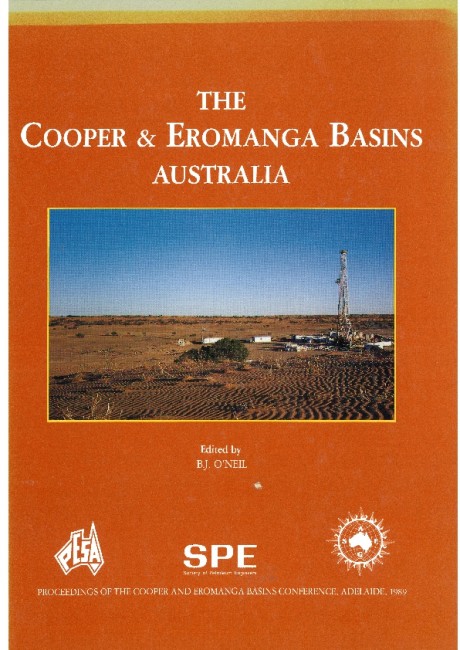Publication Name: The Cooper & Eromanga Basins Australia
Authors: C.C. Jenkins
Date Published: June 1989
Number of Pages: 30
Reference Type: Book Section
Abstract:
Within the South Australian and Queensland sectors of the Cooper and Eromanga Basins, a detailed geochemical study was performed on source rocks and crude oils to define the relative hydrocarbon contributions from each Basin.Source rocks from the Jurassic to Early Cretaceous section of the Eromanga Basin contain Type II to Type III organic matter, the Birkhead Formation being the most hydrogen rich unit. The average total organic carbon (TOC) and hydrocarbon yield of the enrire sequence are 1.6% and 4.3 kg/t respectively, with the yield being marginally less than the considered minimum (5.0 kg/t) for efficient hydrocarbon expulsion. Locally, the Birkhead Formation
has an average TOC of2.5%, with a yield of 10.8 kg/tonne and comprises the major source rock unit. Organic matter is commonly inertinite rich, except for the Birkhead Formation which has a preponderance of vitrinite. Liptinite content varies from 10 to 70% and comprises mainly cutinite and sporinite, with minor resinite and alginite.
For the Cooper Basin source rocks, the average TOC and hydrocarbon yield for the entire sequence are 3.9% and
6.9 kg/t respectively (excluding coals), the yield being slightly in excess of the minimum of 5.0 kg/t. Locally, the
Toolachee Formation averages 7.2% TOC and yields 15.7 kg/t hydrocarbons. The Patchawarra Formation is the other major source rock unit. Organic matter is rich in vitrinite and inertinite. The volume of liptinite is less than 20% but its composition is similar to the Eromanga Basin source rocks.
The hydrocarbon yield from source rocks varies with maturity level and the main stage of volumetrically significant oil generation was determined to be in the vitrinite reflectance range of 0. 7 to 1.0%, for terrestrial
organic matter.
Biomarker distributions are very similar in source rocks from the Cooper and Eromanga Basins but some variations are apparent. Comparison of the steranes and triterpanes indicate local changes in organic facies but the major variation was exhibited by the distribution of two demethylated triterpanes (25,28,30-trisnorhopane and 25,28,30-trisnormoretane of bacterial origin) and a diterpane (19-norisopimarane of resin origin).
Within the study area, 25,28,30-trisnorhopane and 25,28,30-trisnormoretane are virtually unique to the Late
Jurassic to Early Cretaceous source rocks of the Eromanga Basin, while 19-norisopimarane is common throughout the Eromanga Basin sequence. It is rarely found in the Cooper Basin section. Both biomarker groups are useful correlation parameters because they are apparently geological age dependent, unlike the steranes and the majority of the triterpanes. The crude oils were correlated according to the distribution of the Eromanga Basin biomarkers. These biomarkers are absent from all Cooper Basin oil reservoirs but are common in some Eromanga Basin oil reservoirs.
Crude oils were assigned to an Eromanga Basin source if one (or both) of the biomarker groups were present.
These data suggest a maximum Eromanga Basin contribution of 40% by pool but only 17% by volume. By corollary, the bulk of the oil accumulations are sourced from the Cooper Basin sequence. No unique Cooper Basin biomarker was recognised but this will be necessary to define the contributions of Cooper and Eromanga sourced
oil further.
These results will assist in the development of a petroleum generative model for the Cooper and Eromanga
Basins.


